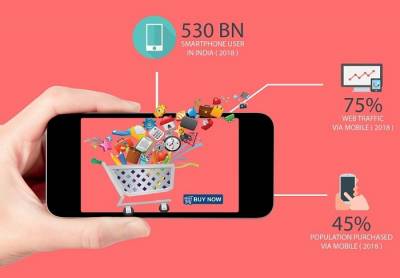Indepth: How m-comm has become a crucial touchpoint for online shoppers - Part 1
The slew of festive season sales on e-commerce platforms has given a huge impetus to online shopping in India, so much so that the effects are now being seen on offline retail sales. According to media reports, a statement issued by the Confederation of All India Traders (CAIT) soon after Diwali acknowledged the fact that there was a fall in the number of consumers visiting retail outlets for their festival shopping this year. A study by Oath revealed that sales increased 29 per cent year-over-year in September 2018, setting a record high for India’s festive shopping season online.
Thanks to the growing smartphone proliferation and adoption in India, more and more people are shopping online through their mobile phones. According to Criteo’s findings, retail sales from mobile web in the weeks leading to Diwali last year saw an increase of 128 per cent. Offering ease of convenience, mobile phones have become the prime point of brand interaction with consumers. Apps represent the most personalised channel to reach India’s consumers.
In this two-part in-depth report, Adgully looks at the growth of e-commerce in the mobile space, the factors that are fuelling this growth, the app economy, innovations & initiatives, and more.
The relationship between apps & consumers
Siddarth Dabhade, General Manager, Criteo, noted, “The importance of mobile apps among shoppers is growing, which reinforces the ‘mobile-first’ mindset. Therefore, App has now become a crucial touchpoint for a shopper’s journey. According to Criteo’s ‘App Commerce India Survey 2017’, about 74 per cent of Indian respondents have installed 2-5 retail and shopping apps on their smartphones. Conversion rates are 5 times higher on app, which shows increase in consumer reviews and response to queries. Globally, advertisers saw nearly a 50 per cent year-over-year increase of in-app transactions, climbing to 46 percent in the fourth quarter of 2017.”
He further said, “Mobile apps are also bringing changes with respect to online payments and return policy. With convenience in shopping, consumers are also expecting flexible return policies. Also, apps have given a boost to the different forms of online payment methods.”
Shekhar Mhaskar, EVP and India Lead for Isobar Commerce, added here, “As we all know, e-commerce started on the desktop, where the Internet connection was primarily via Wi-Fi. But things changed rapidly when mobile data speeds got better and cheaper. Mobile became the go to device for everything – entertainment, information, shopping, etc. Also, the penetration of mobile beyond the Tier 1 and 2 cities, and the improved shopping experience on apps using latest technologies has impacted how consumers shop. Due to all these factors, consumers have started buying on the move more frequently, and spending more than usual.”
He also noted that because more brands are at their disposal on these apps, shoppers don’t frequent the brick and mortar shops as much as they used to earlier. Moreover, the apps have enabled cross border commerce bringing foreign products within the reach of the local shopper. Instead of shop hopping, they now app hop on their phones to find the best deals. It is not only white goods or FMCG, but also services that people have started to buy using mobile apps. Services like cab hailing, booking restaurants, house maintenance, appliances repair, etc. Mobile apps have brought the world at their fingertips.
Agreeing with Dabhade and Mhaskar, Ritika Taneja, Head - Category Management, ShopClues, said, “Mobile apps have taken the world by storm. There really is an app for almost anything, and e-commerce is not one to get left behind. More and more e-commerce businesses are creating apps of their own and it seems that this is one good step for the industry. App is opened in short bursts compared to longer sessions on desktop, but the overall time spent and engagement is high due to small screen size, constant availability of users and access to user data on app. As a result, user conversions are almost 2X than desktop world with very high engagement levels.”
She further emphasised that, “Customers hold the power in the market, as they have a vast number of offers to pick from. Thus, it is not solely your product that allows you to stand out from competitors; it is a customer-centric shopping experience built around your brand to keep customers. Everything from an intuitive order process and payment possibilities to fast delivery has an impact. This augmented service is intangible and requires a lot of effort. It is here that new e-commerce technologies and applications offer solutions.”
Innovations in mobile apps
According to Isobar’s Mhaskar, e-commerce apps have changed drastically over the last few years. “Having used and tracked a few apps, here are a few notable improvements. This summary is drawn from my use of popular apps like Myntra, Jabong, Flipkart, Amazon, Lenskart, etc. There are also a few new ones like Club Factory, PharmEasy, Urban Ladder, Pepperfry, Grofers, etc.
Earlier, these apps used to have a mere product listing from where you could buy, and would maintain an order history. The payment methods were also limited to a Credit Card, Debit Card, and Net Banking. The UX and UI were also very rudimentary and not very intuitive. At times the display had a lag, or the payment process would suddenly get hindered. Not many user signals were captured to offer a more customised, seamless and continuous experience for returning users.
Over the years there has been a drastic improvement in all aspects. The user interfaces today are slick and appealing, and offer a more intuitive navigation to provide a quicker find of what the users are looking for. Categorisation and filtering of items is more logical and human-like, in addition to it being easier and faster. There is even assisted search to reduce the time to find the right product. One can now search by even uploading a picture of a garment or scanning a bar code, or even talking into the speaker. Certain apps even let the user wear the product (for example, spectacles) in VR to see how it looks on him/ her.
The user navigation is closely tracked to understand the consumer behaviour so that the returning user is offered a more tailored experience using AI and ML. The apps track what’s waiting in the wish list only to send alerts of a price drop, or a better offer so that the loop is closed. Also, the improved checkout processes and a plethora of payment options have led to a wider usage of these apps. Last but not the least, even the after sales experience is streamlined via the apps themselves - be it exchanges, refunds, solving queries, etc. Chatbots have come handy here.”
Today, all well-known brands are represented online by an e-commerce store, shopping apps, marketplaces or even all of these things simultaneously. Every effort is made to acquire more clients online. Here are the trends currently shaping the e-commerce industry.
Dabhade of Criteo remarked that the credit for the boom in the e-commerce sector in India also went to the mobile apps, amongst other factors, which had brought a revolution in the way Indian consumers shopped. From desktop to now mobile apps, people can shop on-the-go, saving time and money. Mobile apps are offering convenience to Indian consumers. To keep the consumers engaged, we saw certain innovations over the years in the e-commerce apps. Personalization of app marketing has been quite big. This helps in better engagement, brings dormant users back to app and reduces app un-install. “In the space of creatives, since each consumer has their own preferences of creatives, colors, layout, etc., there is micro-customisation of creatives. Then we have the application of machine learning, which is crucial for achieving these recent innovations,” he added.























Share
Facebook
YouTube
Tweet
Twitter
LinkedIn